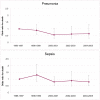Recent trends in acute lung injury mortality: 1996-2005
- PMID: 19325464
- PMCID: PMC2696257
- DOI: 10.1097/CCM.0b013e31819fefdf
Recent trends in acute lung injury mortality: 1996-2005
Abstract
Objective: Studies from single centers have suggested that mortality from acute lung injury (ALI) has declined over time. However, recent trends in ALI mortality from centers across the United States are unknown. We sought to determine whether recent advances in the treatment of ALI and related critical illnesses have resulted in decreased mortality from ALI.
Design: Retrospective cohort study of patients enrolled in the Acute Respiratory Distress Syndrome (ARDS) Network randomized controlled trials.
Setting: Adult intensive care units participating in the ARDS Network trials.
Patients: 2,451 mechanically ventilated patients with ALI enrolled in the ARDS Network randomized controlled trials between 1996 and 2005.
Measurements and main results: Crude mortality was 35% in 1996-1997 and declined during each subsequent time period to a low of 26% in 2004-2005 (test for trend p < 0.0005). After adjusting for demographic and clinical covariates, including receipt of lower tidal volume ventilation and severity of illness, the temporal trend persisted (test for trend p = 0.002). When analyzed by individual causes of lung injury, there were not any statistically significant temporal trends in 60-day mortality for the most common causes of lung injury (pneumonia, sepsis, aspiration, and trauma).
Conclusions: Over the past decade, there seems to be a clear temporal improvement in survival among patients with ALI treated at ARDS Network centers. Our findings strongly suggest that other advancements in critical care, aside from lower tidal volume ventilation, accounted for this improvement in mortality.
Figures




Comment in
-
Acute respiratory distress syndrome and the Art of War.Crit Care Med. 2009 May;37(5):1798-9. doi: 10.1097/CCM.0b013e3181a09310. Crit Care Med. 2009. PMID: 19373048 No abstract available.
References
-
- Estenssoro E, Dubin A, Laffaire E, et al. Incidence, clinical course, and outcome in 217 patients with acute respiratory distress syndrome. Crit Care Med. 2002;30:2450–6. - PubMed
-
- Frutos-Vivar F, Nin N, Esteban A. Epidemiology of acute lung injury and acute respiratory distress syndrome. Curr Opin Crit Care. 2004;10:1–6. - PubMed
-
- Rubenfeld GD, Caldwell E, Peabody E, et al. Incidence and outcomes of acute lung injury. N Engl J Med. 2005;353:1685–93. - PubMed
-
- Ashbaugh DG, Bigelow DB, Petty TL, Levine BE. Acute respiratory distress in adults. Lancet. 1967;2:319–23. - PubMed
Publication types
MeSH terms
Grants and funding
LinkOut - more resources
Full Text Sources
Other Literature Sources
Medical
Miscellaneous

